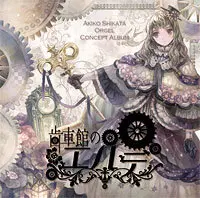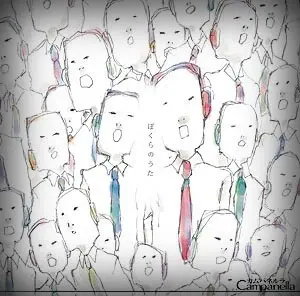コープスパーティー Tortured Souls -暴虐された魂の呪叫-
↑ Let's call it CPTS.
Although I wanted to talk about my own thoughts a few days ago, I couldn't because there was things much more interesting than writing for this failed work. I was planning to keep a 1080p copy but now I changed my mind. u_u
However, I did enjoy this "happy" anime -- I couldn't stop laughing while watching the 4 episodes in a row. As a big fan of the original game (hmm, I didn't play CP2U because I don't have a PSP), there are so many scenes to place my butting-in comments.
I bet people who are new to this work will be lost unless they watch solely because it's a horror anime. Fans of the original game will not be satisfied because it lacks proper structure to make everything continuous. As an OVA, the characters are not that well-drawn.
Probably, the only good things of CPTS are its opening theme song and the unchanged cast voice list...
↑ Let's call it CPTS.
Although I wanted to talk about my own thoughts a few days ago, I couldn't because there was things much more interesting than writing for this failed work. I was planning to keep a 1080p copy but now I changed my mind. u_u
However, I did enjoy this "happy" anime -- I couldn't stop laughing while watching the 4 episodes in a row. As a big fan of the original game (hmm, I didn't play CP2U because I don't have a PSP), there are so many scenes to place my butting-in comments.
I bet people who are new to this work will be lost unless they watch solely because it's a horror anime. Fans of the original game will not be satisfied because it lacks proper structure to make everything continuous. As an OVA, the characters are not that well-drawn.
Probably, the only good things of CPTS are its opening theme song and the unchanged cast voice list...
★SPOILER ALERT★
I'm not responsible if you get spoiled by reading any of the following text.
I'm not responsible if you get spoiled by reading any of the following text.
The rest three episodes are still acceptable, but the first episode goes so quick and -- what is also more fatal -- it lacks proper transitions.
I noticed it since the very beginning: how they got trapped. (They missed some funny moments). However, the beginning, though changed a little bit, is not bad. I actually don't ask for 100% original content as long as the entire framework is reasonable. But the following ep1's main story is getting rather funny -- Yes, all major events in the game between our Bilibili (Naomi) and Hentai Lady (Seiko) were included: that at the entranceway, that in the infirmary, and that ointment event. :P Such parts excite me, but as I said before, they flow too quick and lack connection. I couldn't stop complaining while seeing the previous frame just ended their conversation and being jumped into the infirmary in the next frame. Also, the quarrel at the end looks a bit abnormal -- do you believeKuroko can run away from Naomi solely because of Naomi's impulsive blame? I don't.
By the way, the famous "stepping-onto-someone's-large-intestine" happened when Seiko is by herself. << They should at least keep this as original, the conversation was so funny!
◆Seiko dies, and Naomi is warned by Mild Seven (Naho) that she's the only living person in this dimension.
I noticed it since the very beginning: how they got trapped. (They missed some funny moments). However, the beginning, though changed a little bit, is not bad. I actually don't ask for 100% original content as long as the entire framework is reasonable. But the following ep1's main story is getting rather funny -- Yes, all major events in the game between our Bilibili (Naomi) and Hentai Lady (Seiko) were included: that at the entranceway, that in the infirmary, and that ointment event. :P Such parts excite me, but as I said before, they flow too quick and lack connection. I couldn't stop complaining while seeing the previous frame just ended their conversation and being jumped into the infirmary in the next frame. Also, the quarrel at the end looks a bit abnormal -- do you believe
By the way, the famous "stepping-onto-someone's-large-intestine" happened when Seiko is by herself. << They should at least keep this as original, the conversation was so funny!
◆Seiko dies, and Naomi is warned by Mild Seven (Naho) that she's the only living person in this dimension.
CPTS changed the situations of our Class Rep (Ayumi), the Badness (Kishinuma) and Sensei (Yui) a little bit. Seems Sensei isn't together with the rest two (they changed it because they also think it's too odd to have a closet with kitchen knives, chisels and scalpels? xD). She goes into the infirmary and triggered Mayu getting smashed and thus became Mayu-chanjam. (And I still wonder at what speed a person's body can be smashed like that...)
Our Necrophilia (Morishige) looks as usual at the beginning. Since there were quite a lot of scenes of him, I though they might take things from "Book of Shadows (CPBS)", but I was wrong. His turn is too short. Being seen by our Ordinary Hero (Satoshi) and his Bro-con sister (Yuka) while taking photos of his favorite "artwork", being exhausted and thus enjoys his "collection", followed by the canonical calling -- No, it's not the end here! However, this change made me deducted an additional mark from my overall rating of CPTS... I'll go back to this point shortly.
◆Yui witnesses Mayu getting smeshed; Morishige takes shot of Mayu-jam and soon knows the truth.
Our Necrophilia (Morishige) looks as usual at the beginning. Since there were quite a lot of scenes of him, I though they might take things from "Book of Shadows (CPBS)", but I was wrong. His turn is too short. Being seen by our Ordinary Hero (Satoshi) and his Bro-con sister (Yuka) while taking photos of his favorite "artwork", being exhausted and thus enjoys his "collection", followed by the canonical calling -- No, it's not the end here! However, this change made me deducted an additional mark from my overall rating of CPTS... I'll go back to this point shortly.
◆Yui witnesses Mayu getting smeshed; Morishige takes shot of Mayu-jam and soon knows the truth.
Meanwhile, in case of Satoshi and SatokoYuka, they got attracted by Illya (Sachiko) too early -- their part is likely adapted from BS. Only after a moment, Satoshi is transferred and leaves Yuka by herself. I personally don't like the scene when Satoshi found Kizami's student ID, which is also Kizami's first entry into CPTS. -- Right, before I go more into Kizami's part, I need to go back to Morishige. Yuka is in the annex looking for his brother, so she meets Morishige, who is beating a dead person. In CPBS, he's at least keeping sane to not hurt Yuka, but here in CPTS, he completely turns into a hopeless murder. "Because you made a promise with Mayu to be together with her, now let me beat you onto the wall to get it come true." (--don't you think you should be the ONLY one being with Mayu??) This makes Yuka running away and hiding herself, which getting this work's No.1 Sis-Con (Kizami) stepping onto the stage. He at first helps Yuka and finally wants to kill her but unfortunately gets struck by the Berserk (Yoshikazu). Think it's the same as the original work? Well, sort of. Before, Kizami killed Kurosaki Ichigo, now, he kills Morishige. Fine, I know the staff hate him (but I don't!) and this does make sense. Yet comparing with our Necrophilia Morishige, Kizami's part is even worse. I think the biggest failure here is the staff didn't include even a tiny piece telling how Kizami developped his mental status (killing small animals and enjoying watching the end of life). In CPTS, Kizami just looks like a broken person, has no difference from any others who turn insane at this place.
◆Yuka gets separated from Satoshi, runs away from Morishige. Morishige is cut at neck by Kizami, Kizami goes broken.
◆Yuka gets separated from Satoshi, runs away from Morishige. Morishige is cut at neck by Kizami, Kizami goes broken.
On the other hand, the main culprit who bring everyone into that place, Ayumi, with Kishinuma, talk to Naho, get an old doll when her spirit disappears (I myself prefer the creepier appearance of the doll in the game), and then find out a bloody bag. They haven't confirmed what's in it, the Yoshizawa attacks them but then they by chance know the bag can help those brats (actually the scene of they opening the bag is more interesting... and, aren't you just a Classroom-komori?), so they go for all the rest bags. After the next house-quake, they are taken back to their normal world. Soon, after a boring talk with the Eye-less (Yuki), Ayumi experiences the scene of murder, knows the truth and decides to return and help others.
This whole part is so crappy. They skipped the swimming pool part (which is the most interesting), and the last words from the doll (which I even wanted to set the laughing as my ringtone) and how they meet Morishige and get the last bag from him (well, he's dead already in CPTS). Such changes made the combination of our Class Rep and the Badness isn't that "entertaining" as usual? -- Probably it's also because most of their funny stories are from wrong ends. :3
Another failed point is the scene of murder, I remember the anxious feeling at this part in game. But in CPTS, they used only few minutes -- Don't you think a long span of silence + black screen can make people feeling nervous? -- I guess some people would not realise what's going on when the scene ends.
◆Ayumi and Kishinuma help the kids and are sent back to the normal world and Ayumi decides to return.
This whole part is so crappy. They skipped the swimming pool part (which is the most interesting), and the last words from the doll (which I even wanted to set the laughing as my ringtone) and how they meet Morishige and get the last bag from him (well, he's dead already in CPTS). Such changes made the combination of our Class Rep and the Badness isn't that "entertaining" as usual? -- Probably it's also because most of their funny stories are from wrong ends. :3
Another failed point is the scene of murder, I remember the anxious feeling at this part in game. But in CPTS, they used only few minutes -- Don't you think a long span of silence + black screen can make people feeling nervous? -- I guess some people would not realise what's going on when the scene ends.
◆Ayumi and Kishinuma help the kids and are sent back to the normal world and Ayumi decides to return.
But like a wrong end in game, Kishinuma refuses going back. Yet unlike that wrong end, he indeed does something rather than turns darken. Ayumi enters the science room and tries to help Yuka and meets Kishinuma who hits onto Kizami the Model (a human model can kill others -_-). But seems the staff hate Kishinuma too, so our Badness is also killed by the Berserk. Satoshi, who knows the way to return, goes across dimensions and meets Naomi. He followes Yuka's voice and finds Ayumi and Yuka and the dead Kishinuma. Anyhow, maybe Yuka is the hardest person in CPTS?! She doesn't die after being stabbed at thigh, eye, and heart (or somewhere near it). Plus, isn't Yuka supposed to ask Satoshi saying he loves her? It's a shame that her last words were "going home together"! XD
◆Yuka and Kishinuma are killed by Kizami and Berserk.
◆Yuka and Kishinuma are killed by Kizami and Berserk.
Satoshi doesn't going broken in CPTS either. Based on the previous events, I thought the staff were planning the "all-dying" end (Ayume the Invincible Iron Fist is so MOE). But up to this point, I thought they were going to the "loop end". Anyway, afterwards, Ayumi, Naomi and Satoshi watch Kibiki's video tape, know what happened between Naho and him. They then split up to find out how to make Illya rest in peace.
Naho knows the truth about herself and disappears; Naomi and Satoshi see how Illya's mother dies and how headmaster kills Illya. Yui dies in front of Ayumi. The staff hate Yui as well (I feel like they hate everyone). They killed Yui in one second by an accident -- she might only die in this way, she didn't get hurt by the knief-closet after all... Naomi and Satoshi enter the dissection room and see the Berserk cuts off Seiko's tongue. Naomi then follows him and sees what happened during Seiko's death. But she retrieves sanity after receiving tons of Seiko's message (or she accelerates turning dark while seeing them). Satoshi and Ayumi first find where Illya's body is, and try to convince her. You'll know, they all have the "main char's aura" and this or that necessary props, they success and go back to the normal world. But, since Naomi lost her piece, Satoshi gives her his and he says he'll use Yuka's because they don't know what will happen if you don't use the same piece as what you used to come here (again, I want to see Ayumi burns her piece!).
Naho knows the truth about herself and disappears; Naomi and Satoshi see how Illya's mother dies and how headmaster kills Illya. Yui dies in front of Ayumi. The staff hate Yui as well (I feel like they hate everyone). They killed Yui in one second by an accident -- she might only die in this way, she didn't get hurt by the knief-closet after all... Naomi and Satoshi enter the dissection room and see the Berserk cuts off Seiko's tongue. Naomi then follows him and sees what happened during Seiko's death. But she retrieves sanity after receiving tons of Seiko's message (or she accelerates turning dark while seeing them). Satoshi and Ayumi first find where Illya's body is, and try to convince her. You'll know, they all have the "main char's aura" and this or that necessary props, they success and go back to the normal world. But, since Naomi lost her piece, Satoshi gives her his and he says he'll use Yuka's because they don't know what will happen if you don't use the same piece as what you used to come here (again, I want to see Ayumi burns her piece!).
Eventually, the last three survivors -- I should say the last two -- Ayumi and Naomi successfully return. You ask about Satoshi? Only his two cut-off arms return, and no one knows where his body is. Because Yuka already dies, he thus has no intend to live so he passes his own piece to Naomi? << My guess.
What the hell is the end!? (゚д゚ )
◆Yui dies. The rest three people convinced Illya and go back to the reality. But only two remained alive in the normal world.
The end, same as the beginning of BS, but without the faceless photo of Seiko. (That's why Ayumi asks her instead of Satoshi to go Sachiko's house in BS?!)
What the hell is the end!? (゚д゚ )
◆Yui dies. The rest three people convinced Illya and go back to the reality. But only two remained alive in the normal world.
The end, same as the beginning of BS, but without the faceless photo of Seiko. (That's why Ayumi asks her instead of Satoshi to go Sachiko's house in BS?!)
Absolutely not a good adapted work, but suits watching for entertainment -- and it's NOT horror!
♥:━:♥♡:━:♡♥:━:♥♡:━:♡♥:━:♥♡:━:♡
Ciel nosurge Genometric Concert Vol.2 just got released a few days ago, can I say I love Haruka and Noriko's parts, and I still dislike Minami Kizuki's voice and keep skipping her tracks.. ^^;





